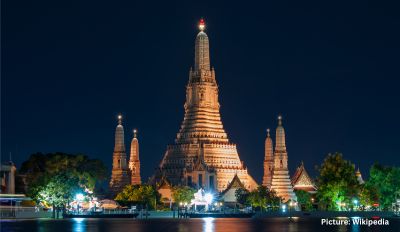The largest Hindu temple in the United States is set to open its doors in New Jersey this Sunday. Located in Robbinsville, the 183-acre BAPS Swaminarayan Akshardham, named after its founding Hindu spiritual organization, rivals major Hindu temples in India.
Yogi Trivedi, a temple volunteer and a scholar of religion at Columbia University, marveled at the temple’s existence, saying, “I wake up every morning and scratch my eyes thinking, ‘Am I still in central New Jersey?’ It’s like being transported to another world, specifically to India.”
The temple is scheduled for official inauguration on October 8, with public access commencing on October 18. For Indian Americans and Hindu Americans, this represents a significant milestone. Trivedi noted, “This is the American Dream. The sacred geography of India and beyond is here in this one place, and you can experience, witness, and admire it all here in New Jersey. I anticipate, as a scholar of religion, that this will become a popular place of pilgrimage for Hindus from across the world.”
Construction of the temple involved 12,500 volunteers from around the world and has been in progress since 2011. However, it gained significant attention a decade later when a group of immigrant laborers filed a lawsuit against the global organization Bochasanwasi Shri Akshar Purushottam Swaminarayan Sanstha (BAPS), which operates temples worldwide. The lawsuit alleged “shocking” conditions, including forced labor, long work hours, inhospitable living conditions, and caste discrimination.
The initial complaint stated, “For these long and difficult hours of work, the workers were paid an astonishing $450 per month, and even less when Defendants took illegal deductions. Their hourly pay rate came to approximately $1.20 per hour.”
BAPS, however, made a distinction between employment and religious volunteer service, known as seva. A spokesperson for BAPS, Ronak Patel, explained, “The artisans who helped to build our mandir came to the U.S. as volunteers, not as employees. We took care of the artisans’ needs in the U.S., including travel, lodging, food, medical care, and internet and prepaid phone cards so they could stay in touch with their families in India. BAPS India also supported the artisans’ families in India, so they did not suffer financial hardship as a result of the artisans’ seva in the U.S.”
 Many of the laborers who participated in the temple’s construction arrived in New Jersey from India on religious visas and belonged to the Dalit community, historically marginalized groups in South Asia’s caste system. The lawsuit claimed that temple leadership enforced the caste hierarchy at work.
Many of the laborers who participated in the temple’s construction arrived in New Jersey from India on religious visas and belonged to the Dalit community, historically marginalized groups in South Asia’s caste system. The lawsuit claimed that temple leadership enforced the caste hierarchy at work.
The lawsuit has been put on hold, with 12 of the original 21 plaintiffs moving to dismiss their claims. BAPS Akshardham spokespeople have assured that the temple will be a place for people of all creeds and castes to gather in community.
The temple’s walls feature carvings of historical figures like Martin Luther King Jr. and Abraham Lincoln, emphasizing inclusivity. Trivedi commented, “When you come to the mandir, you will see people of all genders, all castes, and social backgrounds living, eating, praying, loving, and serving together.”
However, activists argue that the allegations still raise questions about the line between religious service and work exploitation, which particularly affects vulnerable Dalit communities.
Sunita Viswanath, a civil rights activist and co-founder of the civil rights group Hindus for Human Rights, expressed her concerns, saying, “A place of worship, a temple, is such an important space, especially for an immigrant community who’s making a home in a new country. I would want anybody who goes to the temple to really ask themselves, really do some soul searching, about going to a temple where there are such serious allegations of labor and human rights violations.”
The construction of the temple was no small feat, involving the placement of 2 million cubic feet of stone in Robbinsville Township. The temple is a cultural blend, featuring materials sourced from around the world and nods to American history.
The outside of the temple was built with non-traditional Bulgarian limestone to withstand New Jersey’s cold winters. The interior includes stone from various countries, including Greece, Italy, and India. A traditional Indian stepwell contains waters from 300 bodies in India and all 50 U.S. states. Notably, women played key roles in running the project, a rarity in temple construction.
Trivedi sees the temple’s design as representative of the diverse community that will gather there, with inclusivity reflected on the walls. He said, “That kind of inclusivity is not just talked about, it’s actually seen on the walls.”
This landmark Hindu temple in New Jersey, with its rich cultural diversity and complex history, is poised to become a significant focal point for Hindu and Indian American communities across the nation.











